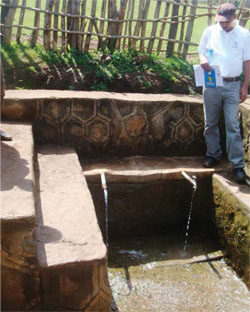
There may not be many opportunities to develop new spring sources but, if the opportunity does arise, there are certain procedures to follow to ensure the spring water is protected and safe to drink. You would be working with others if a new spring source was to be developed but the same principles will apply to existing spring sources because the protection needs to continue to work into the future.
Before using a spring a thorough sanitary survey needs to be carried out at the site to assess the quantity and quality of water, and the possible contamination. If the results of the sanitary survey are satisfactory, the eye of the spring (the point where the water emerges from the ground) should be located by digging out the area around the spring down to the impermeable layer.
Different types of spring protection can be constructed but in general they are as follows:
Springs should be protected from flooding and surface water pollution by constructing a deep diversion ditch above and around the spring. The ditch should be constructed so it collects surface water running towards the spring and carries, or diverts, it away. It needs to be deep enough to carry all surface water away, even in a heavy rainstorm. The surrounding area should be fenced to protect it from animals.
